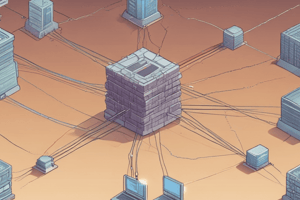Podcast
Questions and Answers
Which layer of the OSI model is responsible for the presentation of information to the user and the acceptance of the user's commands?
Which layer of the OSI model is responsible for the presentation of information to the user and the acceptance of the user's commands?
- Session Layer
- Application Layer (correct)
- Physical Layer
- Transport Layer
What is the function of data access logic in application architectures?
What is the function of data access logic in application architectures?
- Creating, storing, and processing data
- Validation of user input
- Presentation of information to the user
- Processing required to access data (correct)
Which of the following is an example of business logic in application architectures?
Which of the following is an example of business logic in application architectures?
- Presentation of information to the user
- Rules for validating user input (correct)
- Processing required to access data
- Acceptance of user's commands
What is the primary purpose of the application layer in the OSI model?
What is the primary purpose of the application layer in the OSI model?
Which layer of the OSI model involves processing required to access data using database queries in SQL?
Which layer of the OSI model involves processing required to access data using database queries in SQL?
What is the role of presentation logic in application architectures?
What is the role of presentation logic in application architectures?
Which of the following is a function of application programs in application architectures?
Which of the following is a function of application programs in application architectures?
Which of the following is NOT a characteristic of host-based architectures?
Which of the following is NOT a characteristic of host-based architectures?
In client-based architectures, where is the application logic usually located?
In client-based architectures, where is the application logic usually located?
What was one of the key factors that led to the expansion of client-based architectures in the late 1980s?
What was one of the key factors that led to the expansion of client-based architectures in the late 1980s?
In client-based architectures, where is the data stored?
In client-based architectures, where is the data stored?
What is one disadvantage of client-based architectures?
What is one disadvantage of client-based architectures?
Which application architecture provides services (software, platform, and/or infrastructure) to the client?
Which application architecture provides services (software, platform, and/or infrastructure) to the client?
What is a disadvantage of host-based architectures?
What is a disadvantage of host-based architectures?
Which type of client architecture places little or no application logic on the client?
Which type of client architecture places little or no application logic on the client?
Which type of client architecture places all or almost all of the application logic on the client?
Which type of client architecture places all or almost all of the application logic on the client?
What is one advantage of thin-client architecture?
What is one advantage of thin-client architecture?
What is one disadvantage of thick-client architecture?
What is one disadvantage of thick-client architecture?
Is there a direct relationship between thin/thick clients and two/three/n-tier architectures?
Is there a direct relationship between thin/thick clients and two/three/n-tier architectures?
What is the biggest force favoring thin clients?
What is the biggest force favoring thin clients?
In a two-tier architecture with a thin client, where is the application logic placed?
In a two-tier architecture with a thin client, where is the application logic placed?
In a two-tier architecture with a thick client, where is the application logic placed?
In a two-tier architecture with a thick client, where is the application logic placed?
What is the advantage of a three-tier architecture with thin clients?
What is the advantage of a three-tier architecture with thin clients?
Which one of the following is NOT a disadvantage of the n-tier architecture compared to a two-tier architecture?
Which one of the following is NOT a disadvantage of the n-tier architecture compared to a two-tier architecture?
What is the purpose of middleware in a client-server architecture?
What is the purpose of middleware in a client-server architecture?
Which type of architecture balances the load on different servers and provides more power compared to one-tier or two-tier architectures?
Which type of architecture balances the load on different servers and provides more power compared to one-tier or two-tier architectures?
What is one solution to the challenge of getting software from different vendors to work together in a client-server network?
What is one solution to the challenge of getting software from different vendors to work together in a client-server network?
Which component of the client-server architecture accepts user requests and performs the application logic that produces database requests?
Which component of the client-server architecture accepts user requests and performs the application logic that produces database requests?
What is the main advantage of a three-tier architecture compared to a two-tier architecture?
What is the main advantage of a three-tier architecture compared to a two-tier architecture?
What is the primary disadvantage of the n-tier architecture compared to a two-tier architecture?
What is the primary disadvantage of the n-tier architecture compared to a two-tier architecture?
Flashcards are hidden until you start studying
Study Notes
OSI Model – Application Layer
- The application layer is responsible for presenting information to users and accepting user commands.
- It serves as the interface between the user and the underlying network services.
Data Access Logic
- Data access logic manages how data is retrieved or manipulated in application architectures, typically handling database queries.
Business Logic Example
- Business logic refers to the specific rules or algorithms that govern data processing within an application, such as pricing calculations or order processing.
Function of Application Layer
- The primary purpose of the application layer in the OSI model is to facilitate communication between applications, enabling end-users to perform operations.
SQL Data Access
- The data access logic in application architectures involves processing SQL database queries which connect users to required data.
Presentation Logic Role
- Presentation logic determines how information is displayed to users, ensuring the user interface is intuitive and responsive to commands.
Application Programs Function
- Application programs in architectures execute, manage, and facilitate user tasks, acting on data and user input.
Host-Based Architectures
- Characteristics not found in host-based architectures include extensive client processing capabilities and high user interactivity, which are typically client-side features.
Client-Based Architecture
- In client-based architectures, application logic is generally located on the client side of the network.
Expansion of Client-Based Architectures
- Key factors leading to the expansion of client-based architectures in the late 1980s included advances in personal computing and network technology.
Data Storage in Client-Based Architectures
- Data is typically stored on centralized servers, accessible by client devices.
Disadvantages of Client-Based Architectures
- One significant disadvantage is that client devices may require substantial processing power and resources to handle application logic.
Application Architecture Services
- Client-server architecture provides services such as software, infrastructure, and platforms to the client.
Host-Based Architecture Disadvantages
- Host-based architectures can suffer from performance bottlenecks due to centralization of processing and data handling.
Thin vs. Thick Client Architectures
- Thin client architecture places minimal application logic on the client, whereas thick client architecture has most or all application logic on the client side.
Thin-Client Architecture Advantage
- A key advantage of thin-client architecture is reduced resource requirements on client devices, leading to easier management.
Thick-Client Architecture Disadvantage
- One disadvantage of thick-client architecture is the need for more robust client hardware and software, which increases costs.
Client Type vs. Architecture
- There is no direct relationship between client types (thin/thick) and architectural tiers (two/three/n-tier).
Thin-Client Drivers
- The biggest force favoring thin clients is the demand for simpler client management and lower costs in maintaining user devices.
Two-Tier Architecture Application Logic
- In a two-tier architecture with a thin client, application logic is usually managed on the server side.
Thick Client in Two-Tier Architecture
- A two-tier architecture with a thick client typically has application logic primarily executed on the client side.
Three-Tier Architecture Advantages
- A three-tier architecture with thin clients enhances scalability and simplifies updates since application logic is centralized on servers.
N-Tier vs. Two-Tier Disadvantages
- An advantage of n-tier architecture over two-tier is improved performance and resource distribution; not all disadvantages apply.
Middleware Purpose
- Middleware acts as an intermediary that facilitates communication and data management between client and server components in a client-server architecture.
Load Balancing Architecture
- Multi-tier architecture balances loads across different servers, providing greater efficiency and performance compared to simpler architectures.
Vendor Integration Solution
- Solutions to the integration issue across different vendor software in a client-server network often include the use of middleware or standard APIs.
Client-Server Architecture Component
- The application server component accepts user requests and executes application logic to generate database requests.
Three-Tier vs. Two-Tier Advantage
- A primary advantage of a three-tier architecture is enhanced modularity, allowing easier scaling and maintenance compared to two-tier.
N-Tier vs. Two-Tier Disadvantage
- The main disadvantage of n-tier architecture compared to two-tier is increased complexity, which may complicate development and maintenance.
Studying That Suits You
Use AI to generate personalized quizzes and flashcards to suit your learning preferences.




